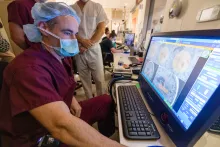Laser Interstitial Thermal Therapy (LITT)
- For all other requests:
- 1-800-777-8442
Laser interstitial thermal therapy (LITT) is a minimally invasive procedure that can treat certain problems in the brain without surgery. These include:
- Brain tumors that start in the brain (primary brain tumors) or come back after treatment (recurrent brain tumors)
- Cancer that spreads to the brain from somewhere else in the body (brain metastases)
- Epilepsy that can’t be controlled with medication
- Inflammation or tissue death caused by brain radiation treatments (radiation necrosis)
University of Iowa Health Care was the first medical center in the state to offer LITT. This means our neurosurgeons have more experience performing it than any other specialists in Iowa.
How LITT works
Laser interstitial thermal therapy is also known as laser ablation or thermal ablation. It’s a minimally invasive treatment option for some people who need brain surgery.
With LITT, we can reach the parts of the skull with less impact on your body to remove a tumor or a piece of brain that’s causing seizures. We use a laser to destroy (ablate) any abnormal or cancerous brain tissue.
Your neurosurgeon will make a single, small hole into your skull. Using an MRI or CT scan for guidance, they’ll insert a tiny, laser-tipped probe through the hole and guide it to the treatment area. The laser will heat up and burn away all the unhealthy tissue, while leaving healthy tissue intact.
Compared to traditional brain surgery, which involves removing part of the skull to reach affected areas of the brain, LITT has a lower risk of complications and a shorter, less painful recovery.
What to expect during LITT
If your provider thinks you may benefit from LITT, you’ll undergo tests to make sure it’s the best treatment for your condition. These tests may include brain imaging scans to see the size and location of a tumor, or intracranial EEG to pinpoint the source of seizures.
Once we confirm you’re a good candidate for LITT, we’ll schedule your procedure.
During your procedure
Your procedure will take place in the hospital. It usually includes the following steps:
We’ll fit you with equipment, such as a blood pressure cuff and oxygen sensor, to monitor your vital signs and a headframe so that your head stays still during the procedure.
You’ll receive general anesthesia, which means you’ll be asleep during your procedure.
Your neurosurgeon will make a tiny incision in your scalp, and then drill a small hole (about the size of a pencil eraser) in your skull. They’ll place a thin, laser-tipped probe through this hole.
Using “maps” of your brain created before surgery, your neurosurgeon will deliver laser heat to the brain tissue that needs to be destroyed.
We’ll remove the probe and close your incision. This usually requires a single stitch.
We use imaging technology throughout the procedure (intraoperative CT or MRI). This helps us make sure we drill the hole in the right place, and insert the probe at the right depth. It also helps us guide the laser so that we only ablate unhealthy brain tissue.
After your procedure
After LITT, most patients stay one night in the hospital. If you experience any pain after you return home, you should call your provider.
- Patients of all ages with a diagnosis of epilepsy
- Patients who have a drug resistance to more standard medical treatments of epilepsy.
- Patients who need to have a brain tumor or radiation necrosis (brain tissue that has been damaged by radiation therapy) removed.
Our Care Team



Do you think you'd benefit from LITT?
Locations and Offices

Related News
